2019届二轮复习语法专题 连词 课件(43张)
文档属性
| 名称 | 2019届二轮复习语法专题 连词 课件(43张) |  | |
| 格式 | zip | ||
| 文件大小 | 845.9KB | ||
| 资源类型 | 教案 | ||
| 版本资源 | 通用版 | ||
| 科目 | 英语 | ||
| 更新时间 | 2019-03-20 09:44:39 | ||
图片预览

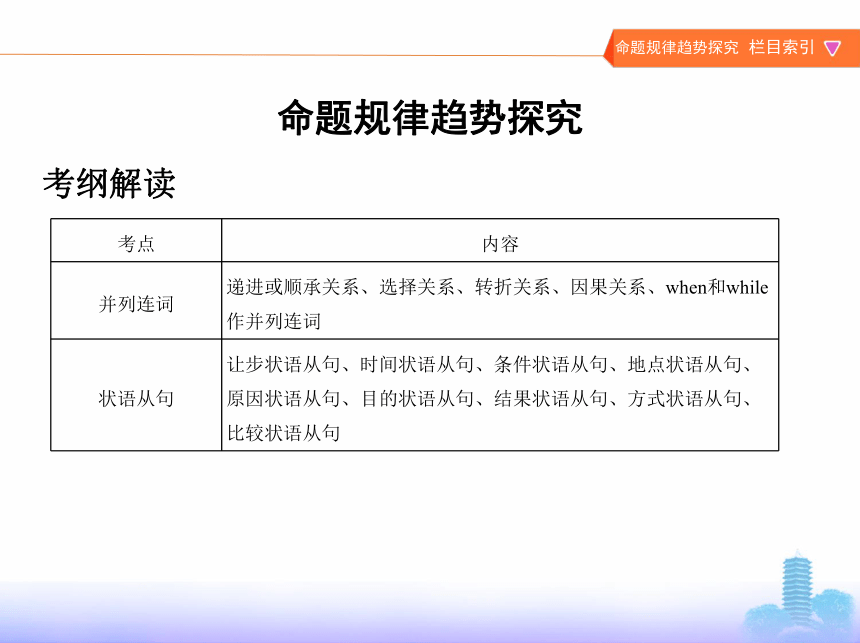
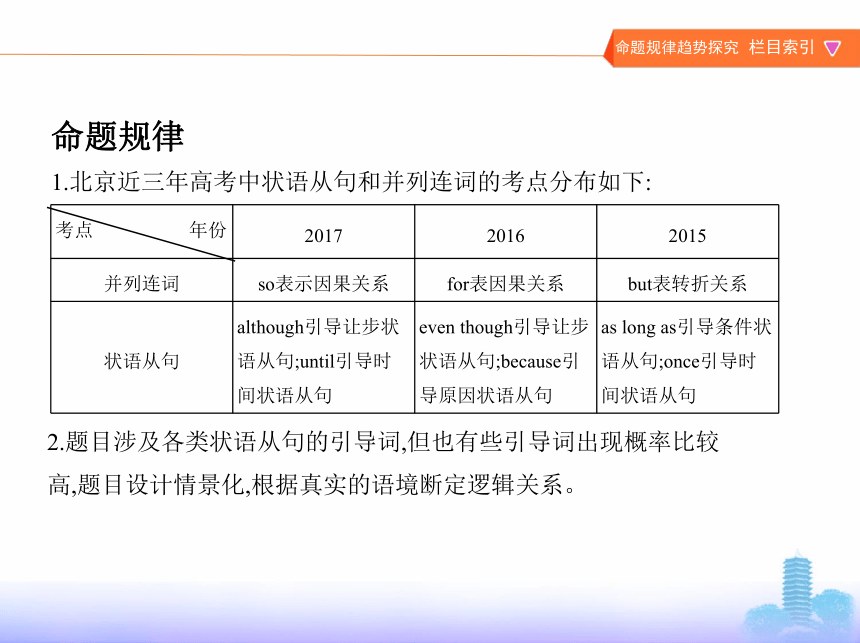
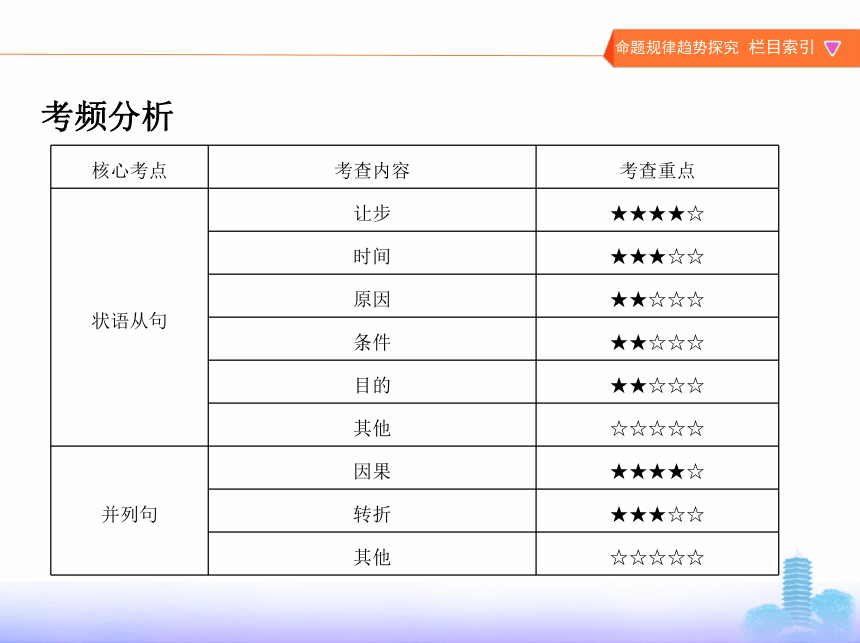

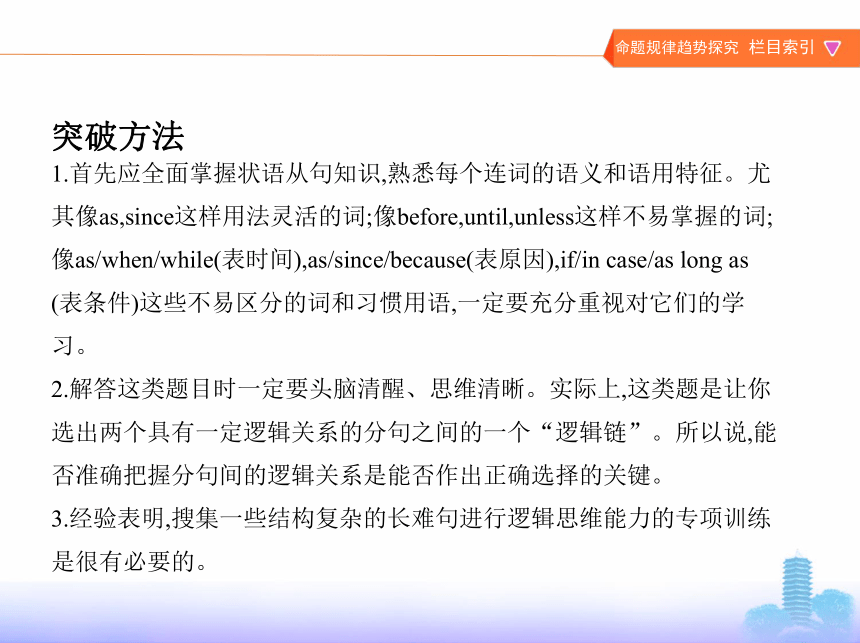
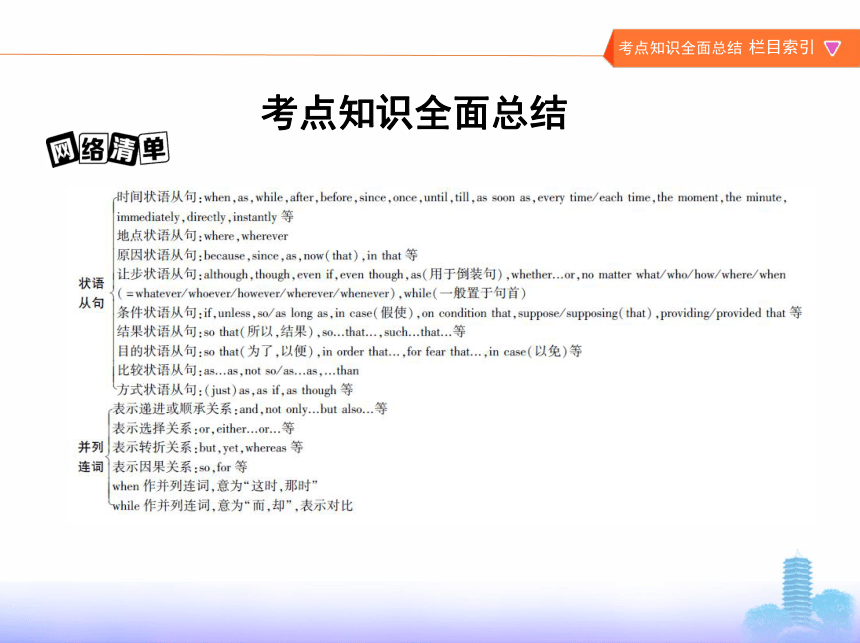
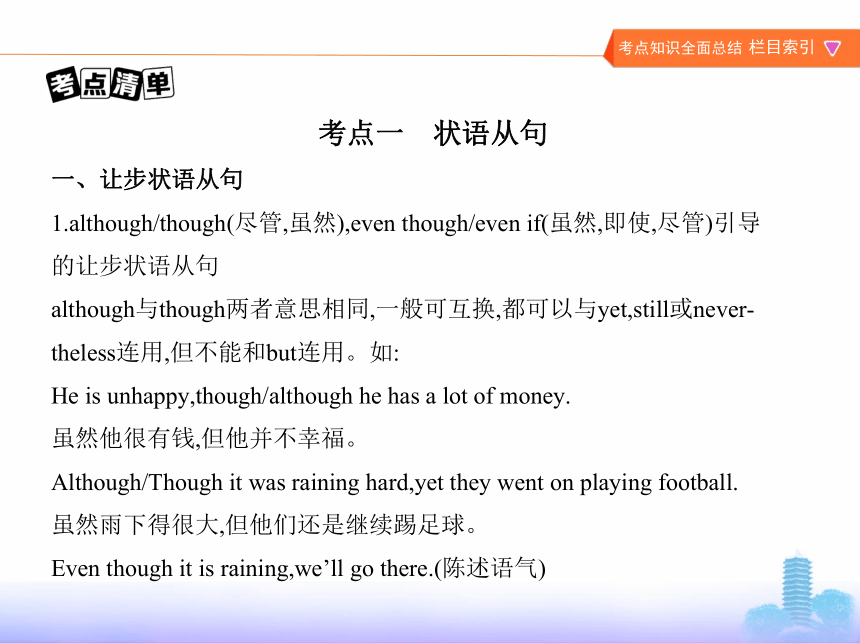
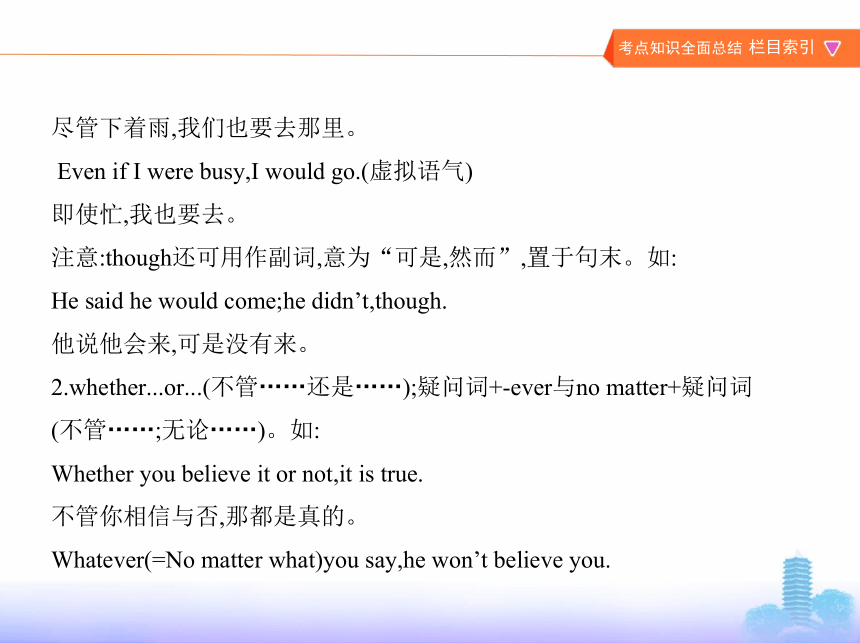
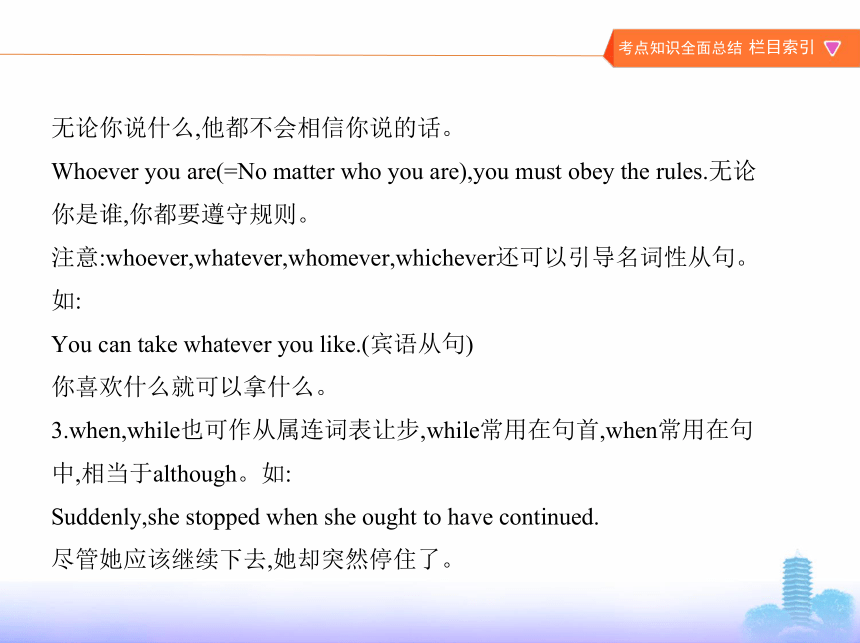
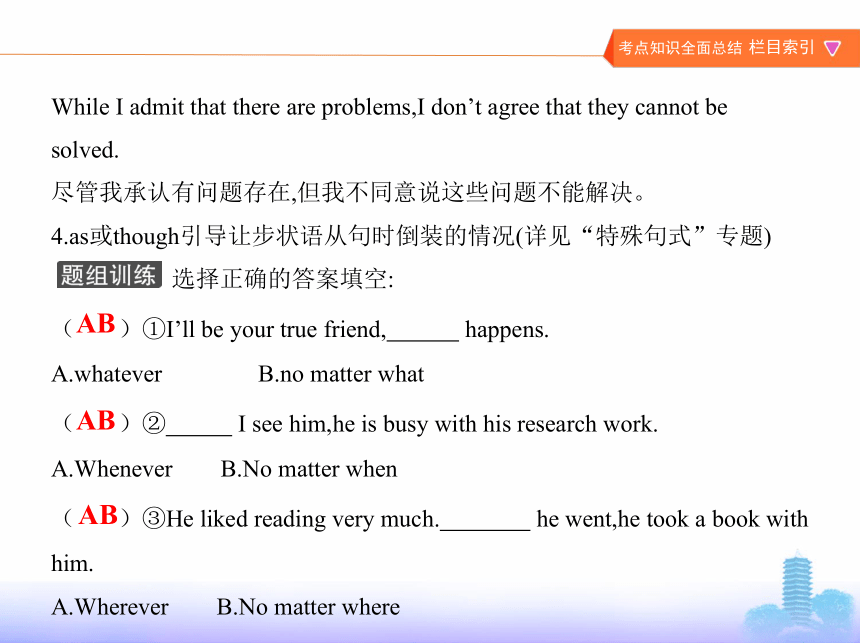
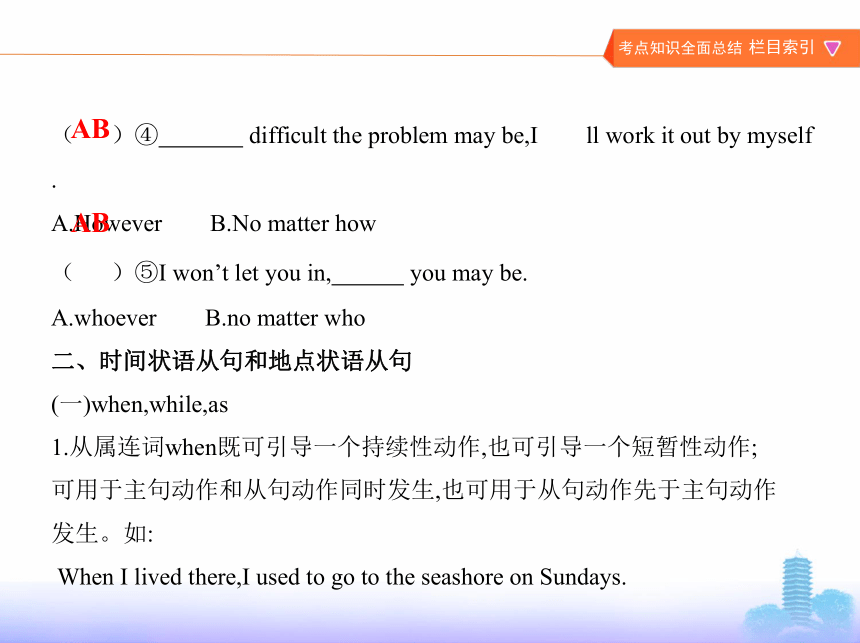
文档简介
课件43张PPT。 2019届二轮复习语法专题状语从句和并列连词考纲解读命题规律趋势探究1.北京近三年高考中状语从句和并列连词的考点分布如下:2.题目涉及各类状语从句的引导词,但也有些引导词出现概率比较
高,题目设计情景化,根据真实的语境断定逻辑关系。命题规律考频分析高考英语北京卷连续5年均对本专题有考查,设题数量稳定在2~3题,每
题1分。通过表格中所列考查点可以看出,北京市高考近五年每年都会
考查一道并列句,主要集中在考查转折关系和因果关系。状语从句也是
每年必考项目,并且从2015年开始增加了题量,考查让步状语从句的频
率最高,偶尔会涉及目的状语从句,原因状语从句和条件状语从句。命题趋势1.首先应全面掌握状语从句知识,熟悉每个连词的语义和语用特征。尤
其像as,since这样用法灵活的词;像before,until,unless这样不易掌握的词;
像as/when/while(表时间),as/since/because(表原因),if/in case/as long as
(表条件)这些不易区分的词和习惯用语,一定要充分重视对它们的学
习。
2.解答这类题目时一定要头脑清醒、思维清晰。实际上,这类题是让你 选出两个具有一定逻辑关系的分句之间的一个“逻辑链”。所以说,能 否准确把握分句间的逻辑关系是能否作出正确选择的关键。
3.经验表明,搜集一些结构复杂的长难句进行逻辑思维能力的专项训练 是很有必要的。突破方法考点知识全面总结考点一 状语从句
一、让步状语从句
1.although/though(尽管,虽然),even though/even if(虽然,即使,尽管)引导 的让步状语从句
although与though两者意思相同,一般可互换,都可以与yet,still或never- theless连用,但不能和but连用。如:
He is unhappy,though/although he has a lot of money.
虽然他很有钱,但他并不幸福。
Although/Though it was raining hard,yet they went on playing football.
虽然雨下得很大,但他们还是继续踢足球。
Even though it is raining,we’ll go there.(陈述语气)尽管下着雨,我们也要去那里。
Even if I were busy,I would go.(虚拟语气)
即使忙,我也要去。
注意:though还可用作副词,意为“可是,然而”,置于句末。如:
He said he would come;he didn’t,though.
他说他会来,可是没有来。
2.whether...or...(不管……还是……);疑问词+-ever与no matter+疑问词 (不管……;无论……)。如:
Whether you believe it or not,it is true.
不管你相信与否,那都是真的。
Whatever(=No matter what)you say,he won’t believe you.无论你说什么,他都不会相信你说的话。
Whoever you are(=No matter who you are),you must obey the rules.无论 你是谁,你都要遵守规则。
注意:whoever,whatever,whomever,whichever还可以引导名词性从句。 如:
You can take whatever you like.(宾语从句)
你喜欢什么就可以拿什么。
3.when,while也可作从属连词表让步,while常用在句首,when常用在句 中,相当于although。如:
Suddenly,she stopped when she ought to have continued.
尽管她应该继续下去,她却突然停住了。While I admit that there are problems,I don’t agree that they cannot be solved.
尽管我承认有问题存在,但我不同意说这些问题不能解决。
4.as或though引导让步状语从句时倒装的情况(详见“特殊句式”专题)
选择正确的答案填空:
( )①I’ll be your true friend,??? ??? happens.
A.whatever B.no matter what
( )②?? ???? I see him,he is busy with his research work.
A.Whenever B.No matter when
( )③He liked reading very much.??? ??? he went,he took a book with him.
A.Wherever B.No matter whereABABAB( )④??? ??? difficult the problem may be,I??ll work it out by myself.
A.However B.No matter how
( )⑤I won’t let you in,??? ??? you may be.
A.whoever B.no matter who
二、时间状语从句和地点状语从句
(一)when,while,as
1.从属连词when既可引导一个持续性动作,也可引导一个短暂性动作; 可用于主句动作和从句动作同时发生,也可用于从句动作先于主句动作 发生。如:
When I lived there,I used to go to the seashore on Sundays.ABAB我住在那里时,星期天常到海滨去。
When the film ended,the people went back.
电影一结束,看电影的人便回去了。
It was an evening when we met for the first time.
我们第一次见面时是在一个晚上。
当when引导的时间状语从句为系表结构,而且其主语和主句的主语一 致,其表语又是一个名词时,就可以用由as引导的省略句来代替when引 导的从句。如:
As a young man(=When he was a young man),he was fond of hunting.
他年轻时喜欢打猎。2.从属连词while引导的动作必须是持续性的,侧重主句动作和从句动作
相对比。如:
Please don’t talk so loud while others are working.
在别人正工作时请别那么大声谈话。
3.从属连词as可表示从句和主句的两个动作交替进行或同时完成,可译 为“一边……,一边……”或“随着……”。如:
He hurried home,looking behind as he went.
他匆匆忙忙回家去,一边走一边回头望。
As time goes on,it’s getting warmer and warmer.
随着时间的推移,天气变得越来越暖和了。
4.如果主句表示的是短暂性动作,而从句用延续性动词的进行时态表示 在一段时间内正在进行的动作,此时when,while与as可互换使用。如:When/While/As I was walking down the street,I came across an old friend of mine.
当我沿大街行走时,碰巧遇到了我的一个老朋友。
(二)as soon as,immediately,directly,instantly,the moment,the minute,the instant和once(一……就……)
这些从属连词引导的从句都表示从句的动作一发生,主句的动作随即发 生,常译为“一……就……”。如:
The moment I heard the voice,I knew my father was coming.
一听到那个声音,我就知道父亲快来了。
The boy burst into tears immediately he saw his mother.
那个男孩一见到他妈妈便放声大哭。注意:no sooner...than...;hardly/scarcely...when...也可表示“一……就……”,
这一结构的时态搭配为:no sooner与hardly/scarcely所在的主句的谓语动词
应用过去完成时,而than与when引导的从句的谓语动词应用一般过去时。
此外,当把no sooner和hardly/scarcely提到句首时,其所在的主句应用倒装语
序。如:
?
? 单项填空:
( )⑥Just use this room for the time being,and we’ll offer you a larger one???? ????it becomes available.
A.as soon as B.unless
C.as far as D.until
( )⑦ ????you start eating in a healthier way,weight control will become much easier.
A.Unless B.Although
C.Before D.OnceAD( )⑧He had no sooner finished his speech ????the students started
cheering.
A.since B.as
C.when D.than
(三)till,until和not...until
1.肯定句:主句的谓语动词必须是延续性动词,主句、从句都为肯定式, 意为“某动作一直延续到某时间点才停止”。如:
He remained there until/till she arrived.
他在那儿一直待到她来。
You may stay here until/till the rain stops.
你可以在这里待到雨停。D2.否定句:主句的谓语动词必须是非延续性动词,从句为肯定式,意为
“某动作直到某时间才开始”。如:
He won’t go to bed till/until she returns.
直到她回来他才会去睡。
3.till不可以置于句首,而until可以。如:
Until you told me I had no idea of it.
直到你告诉我,我才知道这件事。
4.not until...句型的强调和倒装用法。如:
直到你告诉我,我才知道这件事。
It was not until you told me that I had any idea of it.(强调句型)
Not until you told me did I have any idea of it.(not until置于句首,主句要 部分倒装)(四)before和since
1.若表达“还未……就……;不到……就……;……才……;还没来得及 ……就……”时,需用连词before。如:
We had sailed four days and four nights before we saw land.
我们航行了四天四夜才看到陆地。
We hadn’t run a mile before he felt tired.
我们跑了还不到一英里他就感到累了。
Before I could get a word in,he had measured me.
我还没来得及插话,他就给我量好了尺寸。
2.before从句中谓语不用否定式。如:
Before they reached the station,the train had gone.他们到火车站前(他们还没到火车站),火车就已经开走了。
3.“It will be/was+一段时间+before...”常翻译成:……才,……就。如:
It was half a year before I came back.半年后我才回来。
It won’t be long before we meet again.
过不了多久我们就又见面了。
4.since从句的谓语动词一般是非延续性动词,主句的谓语动词是延续性 的或者是反复发生过的动作。since从句的时态若是一般过去时,主句 中的时态常是现在完成时或现在完成进行时。如:
I have written home four times since I came here.
自从我来到这儿,我已经给家里写过四次信了。
She has been working in this factory since she left school.她离开学校以后就一直在这个工厂工作。
5.在“It is+一段时间+since从句”句型中,since引导的从句的谓语动词 若是延续性动词,常理解为某一状态的终止;若是终止性动词,则理解为 某一动作的开始。如:
It is three years since the war broke out.(终止性动词)
自战争爆发以来已有三年了。
It is three years since I smoked(=since I stopped smoking).(延续性动词)
我不吸烟已有三年了。
如果译成“我吸烟已有三年了”,应为:It is three years since I began to smoke.(终止性动词)(五)地点状语从句
1.引导地点状语从句的从属连词where,wherever指具体地点时,从句可 用于主句之前或之后;表示抽象条件的含义时,从句需放在主句之前。 如:
We should go where the Party needs us most.
我们应到党最需要我们的地方去。
You are free to go wherever you like.
你愿意去哪里就去哪里。
Where there is a will,there is a way.
有志者事竟成。
Where there is smoke,there is fire.
无火不生烟。/无风不起浪。2.注意区分where引导的定语从句与状语从句。如:
你最好在有问题的地方做一下标记。
You’d better make a mark where you have any questions.(状语从句)
You’d better make a mark at the place where you have any questions.(定语从句) 英译汉:
⑨It is three years since she was in our class.
?? 她离开我们班已经三年了。 ??
⑩It is three years since he lived here.
??他不在这里住已经三年了。 ??
单项填空:
( )?As is reported,it is 100 years ????Qinghua University was founded.
A.when B.before C.after D.since
( )?After the war,a new school building was put up ???? there had once
been a theatre.
A.that B.where C.which D.whenBD三、条件状语从句
引导条件状语从句的从属连词有:if,unless(=if...not如果不;除非……否 则……),so/as long as(只要),in case(假使,如果),on condition that(条件是), suppose/supposing(that)(假如,如果),providing/provided that(如果)等。 如:
Youll fail the exam unless you study hard(=if you don??t study hard).
除非你努力学习,否则你考试会不及格。
As long as you don’t lose heart,you will succeed.
你只要不灰心就会成功。 Suppose/Supposing(that)they refuse us,who else can we turn to for help?
假如他们拒绝了我们,我们还能求助于谁?
In case there is a fire,what will we do first?
如果发生火灾,我们首先做什么? 单项填空:
( ) You may use the room as you like ????you clean it up afterwards.
A.so far as B.so long as C.in case D.even if
( ) —Our holiday cost a lot of money.
—Did it?Well,that doesn’t matter ????you enjoyed yourselves.
A.as long as B.unless C.as soon as D.thoughBA四、原因状语从句如:
I was absent from the meeting because I was ill.
因为我病了,所以我开会缺席。
As it is raining,we shall not go to the park.
由于在下雨,我们不去公园了。
Now that/Since everybody is here,let’s begin our meeting.
既然大家都在这里,我们开始开会吧。 单项填空:
( ) ????that my head had cleared,my brain was also beginning to work much better.
A.For B.Now C.Since D.Despite
( ) ????you are familiar with the author’s ideas,try reading all the sec
tions as quickly as possible.
A.Now that B.Ever since C.In case D.As long asBA五、目的状语从句和结果状语从句
(一)目的状语从句
引导目的状语从句的从属连词有:so that,in order that,for fear that,in case,
lest等。
1.in order that与so that
两个连词都意为“以便……;为了……”,它们引导的状语从句中需用 情态动词。in order that比so that正式,引导的状语从句可置于主句之前 或之后,而so that引导的从句只能置于主句之后。如:
I’ll speak slowly so that you can understand me.
我会慢慢说,以便你能懂。
In order that we might see the sunrise,we started for the peak early.
为了能看到日出,我们很早就出发去了山顶。2.for fear that与in case
引导目的状语从句时,for fear that表示“害怕,担心”某事会发生;in case
(that)表示“以防(万一)”出现某种情况。如:
Mary didn’t want to get out of bed,for fear that she might wake her baby (up).
玛丽不想起床,担心吵醒她的宝宝。
Take your raincoat,in case it rains.
带上雨衣吧,以防下雨。
(二)结果状语从句
1.引导结果状语从句的从属连词有:so that,so...that...,such...that...。在非 正式语体中,由so...that...,such...that...引导的句子中的that可以省略,注意 其结构:?
?
如:
Mike is such an honest worker that we all believe in him.
=Mike is so honest a worker that we all believe in him.
迈克是一个如此诚实的工人,以至于我们都信任他。
It is such fine weather that we all want to go to the park.
天气如此晴朗,以至于我们都想去公园。He earned so little money that he couldn??t support his family.
他挣的钱这么少,以至于养不起家。
注意:(1)为了强调形容词和副词,当so或such置于句首时,主句要用倒装 语序。如:
So clever a student was he that he was able to work out all the difficult problems.他是如此聪明的一个学生,以至于能够解出所有难题。
(2)当so或such所在的主句主语与结果状语从句中的主语一致时,还可简 化为:so/such...as to...。如:
He was so clever a student that he was able to work out all the difficult problems.→
He was so clever a student as to be able to work out all the difficult prob- lems. 用so或such填空:
?He is such????a smart boy that I like him very much.
?He is so????smart a boy that I like him very much.
2.除了结果状语从句外,too...to...太……而不能……,(not)enough to...(未) 达到某种程度(不)可以……,so...as(not)to...如此……以至于(不能)等不 定式结构同样可以表示结果。如:
他起床太晚了,没有赶上那班公共汽车。
He didn’t get up early enough to catch the bus.
=He got up too late to catch the bus.
=He got up so late as not to catch the bus. 单项填空:
( ) Cathy had quit her job when her son was born ????she could stay
home and raise her family.
A.now that B.as if C.only if D.so that
( ) Leave your key with a neighbor ????you lock yourself out one day.
A.ever since B.even if
C.soon after D.in case
六、方式状语从句
引导方式状语从句的从属连词有:as,as if,as though等。方式状语从句应 放在主句之后。其中as if或as though引导的从句一般用虚拟语气,但如DD果从句中所陈述的情况很可能实现,也可用陈述语气。如:
Do as you are told to,or you’ll be fired.
告诉你怎么做你就怎么做,否则你会被解雇。
The old lady treats the boy as if he were her own son.(虚拟语气)这位老太 太对待这个男孩就像他是她自己的儿子似的。
I feel as if I have a fever.(陈述语气)
我感觉好像发烧了。考点二 并列连词
一、并列连词
并列连词连接两个互不依从的词、短语或分句。如:
Jane and Jim are interested in pop music.简和吉姆都对流行音乐感兴 趣。(连接单词)
She will be back this week or next week.她这周或下周回来。(连接短语)
I like playing the piano while he likes hiking.我喜欢弹钢琴而他喜欢远 足。(连接分句)二、常见的并列连词
1.表示递进或顺承关系:常用的并列连词有and,not only...but(also)...等。 如:
He had plenty of money and he spent it freely.
他有足够的钱,而且他花钱很随便。
Not only did he speak more correctly,but also he spoke more easily.他不仅 说得更准确了,而且说起来也更轻松了。
2.表示选择关系:常用的并列连词有or,either...or...等。如:
Either you are right,or I am.要么你对,要么我对。
3.表示转折和对比关系:常用的并列连词有but,yet,whereas,while等。如:
Jane said she was ill,yet I saw her in the street just now.
简说她病了,但刚才我在街上看到她了。Some of the studies show positive results,whereas others do not.有一些研 究结果令人满意,然而其他的则不然。
4.表示因果关系:常用的并列连词有so,for等。如:
It must have rained last night,for it is wet all over.
昨晚一定下雨了,因为到处都这么湿。
The shops were closed,so I didn’t get any milk.
商店关门了,所以我没买到牛奶。 单项填空:
( )①—I wonder how much you charge for your services.
—The first two are free ????the third costs $30.
A.while B.until C.when D.before
( )②Tom was about to close the window ????his attention was caught
by a bird.
A.when B.if C.and D.tillAA请认真完成高考题组训练 模拟预测题组训练
2.解答这类题目时一定要头脑清醒、思维清晰。实际上,这类题是让你 选出两个具有一定逻辑关系的分句之间的一个“逻辑链”。所以说,能 否准确把握分句间的逻辑关系是能否作出正确选择的关键。
3.经验表明,搜集一些结构复杂的长难句进行逻辑思维能力的专项训练 是很有必要的。突破方法考点知识全面总结考点一 状语从句
一、让步状语从句
1.although/though(尽管,虽然),even though/even if(虽然,即使,尽管)引导 的让步状语从句
although与though两者意思相同,一般可互换,都可以与yet,still或never- theless连用,但不能和but连用。如:
He is unhappy,though/although he has a lot of money.
虽然他很有钱,但他并不幸福。
Although/Though it was raining hard,yet they went on playing football.
虽然雨下得很大,但他们还是继续踢足球。
Even though it is raining,we’ll go there.(陈述语气)尽管下着雨,我们也要去那里。
Even if I were busy,I would go.(虚拟语气)
即使忙,我也要去。
注意:though还可用作副词,意为“可是,然而”,置于句末。如:
He said he would come;he didn’t,though.
他说他会来,可是没有来。
2.whether...or...(不管……还是……);疑问词+-ever与no matter+疑问词 (不管……;无论……)。如:
Whether you believe it or not,it is true.
不管你相信与否,那都是真的。
Whatever(=No matter what)you say,he won’t believe you.无论你说什么,他都不会相信你说的话。
Whoever you are(=No matter who you are),you must obey the rules.无论 你是谁,你都要遵守规则。
注意:whoever,whatever,whomever,whichever还可以引导名词性从句。 如:
You can take whatever you like.(宾语从句)
你喜欢什么就可以拿什么。
3.when,while也可作从属连词表让步,while常用在句首,when常用在句 中,相当于although。如:
Suddenly,she stopped when she ought to have continued.
尽管她应该继续下去,她却突然停住了。While I admit that there are problems,I don’t agree that they cannot be solved.
尽管我承认有问题存在,但我不同意说这些问题不能解决。
4.as或though引导让步状语从句时倒装的情况(详见“特殊句式”专题)
选择正确的答案填空:
( )①I’ll be your true friend,??? ??? happens.
A.whatever B.no matter what
( )②?? ???? I see him,he is busy with his research work.
A.Whenever B.No matter when
( )③He liked reading very much.??? ??? he went,he took a book with him.
A.Wherever B.No matter whereABABAB( )④??? ??? difficult the problem may be,I??ll work it out by myself.
A.However B.No matter how
( )⑤I won’t let you in,??? ??? you may be.
A.whoever B.no matter who
二、时间状语从句和地点状语从句
(一)when,while,as
1.从属连词when既可引导一个持续性动作,也可引导一个短暂性动作; 可用于主句动作和从句动作同时发生,也可用于从句动作先于主句动作 发生。如:
When I lived there,I used to go to the seashore on Sundays.ABAB我住在那里时,星期天常到海滨去。
When the film ended,the people went back.
电影一结束,看电影的人便回去了。
It was an evening when we met for the first time.
我们第一次见面时是在一个晚上。
当when引导的时间状语从句为系表结构,而且其主语和主句的主语一 致,其表语又是一个名词时,就可以用由as引导的省略句来代替when引 导的从句。如:
As a young man(=When he was a young man),he was fond of hunting.
他年轻时喜欢打猎。2.从属连词while引导的动作必须是持续性的,侧重主句动作和从句动作
相对比。如:
Please don’t talk so loud while others are working.
在别人正工作时请别那么大声谈话。
3.从属连词as可表示从句和主句的两个动作交替进行或同时完成,可译 为“一边……,一边……”或“随着……”。如:
He hurried home,looking behind as he went.
他匆匆忙忙回家去,一边走一边回头望。
As time goes on,it’s getting warmer and warmer.
随着时间的推移,天气变得越来越暖和了。
4.如果主句表示的是短暂性动作,而从句用延续性动词的进行时态表示 在一段时间内正在进行的动作,此时when,while与as可互换使用。如:When/While/As I was walking down the street,I came across an old friend of mine.
当我沿大街行走时,碰巧遇到了我的一个老朋友。
(二)as soon as,immediately,directly,instantly,the moment,the minute,the instant和once(一……就……)
这些从属连词引导的从句都表示从句的动作一发生,主句的动作随即发 生,常译为“一……就……”。如:
The moment I heard the voice,I knew my father was coming.
一听到那个声音,我就知道父亲快来了。
The boy burst into tears immediately he saw his mother.
那个男孩一见到他妈妈便放声大哭。注意:no sooner...than...;hardly/scarcely...when...也可表示“一……就……”,
这一结构的时态搭配为:no sooner与hardly/scarcely所在的主句的谓语动词
应用过去完成时,而than与when引导的从句的谓语动词应用一般过去时。
此外,当把no sooner和hardly/scarcely提到句首时,其所在的主句应用倒装语
序。如:
?
? 单项填空:
( )⑥Just use this room for the time being,and we’ll offer you a larger one???? ????it becomes available.
A.as soon as B.unless
C.as far as D.until
( )⑦ ????you start eating in a healthier way,weight control will become much easier.
A.Unless B.Although
C.Before D.OnceAD( )⑧He had no sooner finished his speech ????the students started
cheering.
A.since B.as
C.when D.than
(三)till,until和not...until
1.肯定句:主句的谓语动词必须是延续性动词,主句、从句都为肯定式, 意为“某动作一直延续到某时间点才停止”。如:
He remained there until/till she arrived.
他在那儿一直待到她来。
You may stay here until/till the rain stops.
你可以在这里待到雨停。D2.否定句:主句的谓语动词必须是非延续性动词,从句为肯定式,意为
“某动作直到某时间才开始”。如:
He won’t go to bed till/until she returns.
直到她回来他才会去睡。
3.till不可以置于句首,而until可以。如:
Until you told me I had no idea of it.
直到你告诉我,我才知道这件事。
4.not until...句型的强调和倒装用法。如:
直到你告诉我,我才知道这件事。
It was not until you told me that I had any idea of it.(强调句型)
Not until you told me did I have any idea of it.(not until置于句首,主句要 部分倒装)(四)before和since
1.若表达“还未……就……;不到……就……;……才……;还没来得及 ……就……”时,需用连词before。如:
We had sailed four days and four nights before we saw land.
我们航行了四天四夜才看到陆地。
We hadn’t run a mile before he felt tired.
我们跑了还不到一英里他就感到累了。
Before I could get a word in,he had measured me.
我还没来得及插话,他就给我量好了尺寸。
2.before从句中谓语不用否定式。如:
Before they reached the station,the train had gone.他们到火车站前(他们还没到火车站),火车就已经开走了。
3.“It will be/was+一段时间+before...”常翻译成:……才,……就。如:
It was half a year before I came back.半年后我才回来。
It won’t be long before we meet again.
过不了多久我们就又见面了。
4.since从句的谓语动词一般是非延续性动词,主句的谓语动词是延续性 的或者是反复发生过的动作。since从句的时态若是一般过去时,主句 中的时态常是现在完成时或现在完成进行时。如:
I have written home four times since I came here.
自从我来到这儿,我已经给家里写过四次信了。
She has been working in this factory since she left school.她离开学校以后就一直在这个工厂工作。
5.在“It is+一段时间+since从句”句型中,since引导的从句的谓语动词 若是延续性动词,常理解为某一状态的终止;若是终止性动词,则理解为 某一动作的开始。如:
It is three years since the war broke out.(终止性动词)
自战争爆发以来已有三年了。
It is three years since I smoked(=since I stopped smoking).(延续性动词)
我不吸烟已有三年了。
如果译成“我吸烟已有三年了”,应为:It is three years since I began to smoke.(终止性动词)(五)地点状语从句
1.引导地点状语从句的从属连词where,wherever指具体地点时,从句可 用于主句之前或之后;表示抽象条件的含义时,从句需放在主句之前。 如:
We should go where the Party needs us most.
我们应到党最需要我们的地方去。
You are free to go wherever you like.
你愿意去哪里就去哪里。
Where there is a will,there is a way.
有志者事竟成。
Where there is smoke,there is fire.
无火不生烟。/无风不起浪。2.注意区分where引导的定语从句与状语从句。如:
你最好在有问题的地方做一下标记。
You’d better make a mark where you have any questions.(状语从句)
You’d better make a mark at the place where you have any questions.(定语从句) 英译汉:
⑨It is three years since she was in our class.
?? 她离开我们班已经三年了。 ??
⑩It is three years since he lived here.
??他不在这里住已经三年了。 ??
单项填空:
( )?As is reported,it is 100 years ????Qinghua University was founded.
A.when B.before C.after D.since
( )?After the war,a new school building was put up ???? there had once
been a theatre.
A.that B.where C.which D.whenBD三、条件状语从句
引导条件状语从句的从属连词有:if,unless(=if...not如果不;除非……否 则……),so/as long as(只要),in case(假使,如果),on condition that(条件是), suppose/supposing(that)(假如,如果),providing/provided that(如果)等。 如:
Youll fail the exam unless you study hard(=if you don??t study hard).
除非你努力学习,否则你考试会不及格。
As long as you don’t lose heart,you will succeed.
你只要不灰心就会成功。 Suppose/Supposing(that)they refuse us,who else can we turn to for help?
假如他们拒绝了我们,我们还能求助于谁?
In case there is a fire,what will we do first?
如果发生火灾,我们首先做什么? 单项填空:
( ) You may use the room as you like ????you clean it up afterwards.
A.so far as B.so long as C.in case D.even if
( ) —Our holiday cost a lot of money.
—Did it?Well,that doesn’t matter ????you enjoyed yourselves.
A.as long as B.unless C.as soon as D.thoughBA四、原因状语从句如:
I was absent from the meeting because I was ill.
因为我病了,所以我开会缺席。
As it is raining,we shall not go to the park.
由于在下雨,我们不去公园了。
Now that/Since everybody is here,let’s begin our meeting.
既然大家都在这里,我们开始开会吧。 单项填空:
( ) ????that my head had cleared,my brain was also beginning to work much better.
A.For B.Now C.Since D.Despite
( ) ????you are familiar with the author’s ideas,try reading all the sec
tions as quickly as possible.
A.Now that B.Ever since C.In case D.As long asBA五、目的状语从句和结果状语从句
(一)目的状语从句
引导目的状语从句的从属连词有:so that,in order that,for fear that,in case,
lest等。
1.in order that与so that
两个连词都意为“以便……;为了……”,它们引导的状语从句中需用 情态动词。in order that比so that正式,引导的状语从句可置于主句之前 或之后,而so that引导的从句只能置于主句之后。如:
I’ll speak slowly so that you can understand me.
我会慢慢说,以便你能懂。
In order that we might see the sunrise,we started for the peak early.
为了能看到日出,我们很早就出发去了山顶。2.for fear that与in case
引导目的状语从句时,for fear that表示“害怕,担心”某事会发生;in case
(that)表示“以防(万一)”出现某种情况。如:
Mary didn’t want to get out of bed,for fear that she might wake her baby (up).
玛丽不想起床,担心吵醒她的宝宝。
Take your raincoat,in case it rains.
带上雨衣吧,以防下雨。
(二)结果状语从句
1.引导结果状语从句的从属连词有:so that,so...that...,such...that...。在非 正式语体中,由so...that...,such...that...引导的句子中的that可以省略,注意 其结构:?
?
如:
Mike is such an honest worker that we all believe in him.
=Mike is so honest a worker that we all believe in him.
迈克是一个如此诚实的工人,以至于我们都信任他。
It is such fine weather that we all want to go to the park.
天气如此晴朗,以至于我们都想去公园。He earned so little money that he couldn??t support his family.
他挣的钱这么少,以至于养不起家。
注意:(1)为了强调形容词和副词,当so或such置于句首时,主句要用倒装 语序。如:
So clever a student was he that he was able to work out all the difficult problems.他是如此聪明的一个学生,以至于能够解出所有难题。
(2)当so或such所在的主句主语与结果状语从句中的主语一致时,还可简 化为:so/such...as to...。如:
He was so clever a student that he was able to work out all the difficult problems.→
He was so clever a student as to be able to work out all the difficult prob- lems. 用so或such填空:
?He is such????a smart boy that I like him very much.
?He is so????smart a boy that I like him very much.
2.除了结果状语从句外,too...to...太……而不能……,(not)enough to...(未) 达到某种程度(不)可以……,so...as(not)to...如此……以至于(不能)等不 定式结构同样可以表示结果。如:
他起床太晚了,没有赶上那班公共汽车。
He didn’t get up early enough to catch the bus.
=He got up too late to catch the bus.
=He got up so late as not to catch the bus. 单项填空:
( ) Cathy had quit her job when her son was born ????she could stay
home and raise her family.
A.now that B.as if C.only if D.so that
( ) Leave your key with a neighbor ????you lock yourself out one day.
A.ever since B.even if
C.soon after D.in case
六、方式状语从句
引导方式状语从句的从属连词有:as,as if,as though等。方式状语从句应 放在主句之后。其中as if或as though引导的从句一般用虚拟语气,但如DD果从句中所陈述的情况很可能实现,也可用陈述语气。如:
Do as you are told to,or you’ll be fired.
告诉你怎么做你就怎么做,否则你会被解雇。
The old lady treats the boy as if he were her own son.(虚拟语气)这位老太 太对待这个男孩就像他是她自己的儿子似的。
I feel as if I have a fever.(陈述语气)
我感觉好像发烧了。考点二 并列连词
一、并列连词
并列连词连接两个互不依从的词、短语或分句。如:
Jane and Jim are interested in pop music.简和吉姆都对流行音乐感兴 趣。(连接单词)
She will be back this week or next week.她这周或下周回来。(连接短语)
I like playing the piano while he likes hiking.我喜欢弹钢琴而他喜欢远 足。(连接分句)二、常见的并列连词
1.表示递进或顺承关系:常用的并列连词有and,not only...but(also)...等。 如:
He had plenty of money and he spent it freely.
他有足够的钱,而且他花钱很随便。
Not only did he speak more correctly,but also he spoke more easily.他不仅 说得更准确了,而且说起来也更轻松了。
2.表示选择关系:常用的并列连词有or,either...or...等。如:
Either you are right,or I am.要么你对,要么我对。
3.表示转折和对比关系:常用的并列连词有but,yet,whereas,while等。如:
Jane said she was ill,yet I saw her in the street just now.
简说她病了,但刚才我在街上看到她了。Some of the studies show positive results,whereas others do not.有一些研 究结果令人满意,然而其他的则不然。
4.表示因果关系:常用的并列连词有so,for等。如:
It must have rained last night,for it is wet all over.
昨晚一定下雨了,因为到处都这么湿。
The shops were closed,so I didn’t get any milk.
商店关门了,所以我没买到牛奶。 单项填空:
( )①—I wonder how much you charge for your services.
—The first two are free ????the third costs $30.
A.while B.until C.when D.before
( )②Tom was about to close the window ????his attention was caught
by a bird.
A.when B.if C.and D.tillAA请认真完成高考题组训练 模拟预测题组训练
